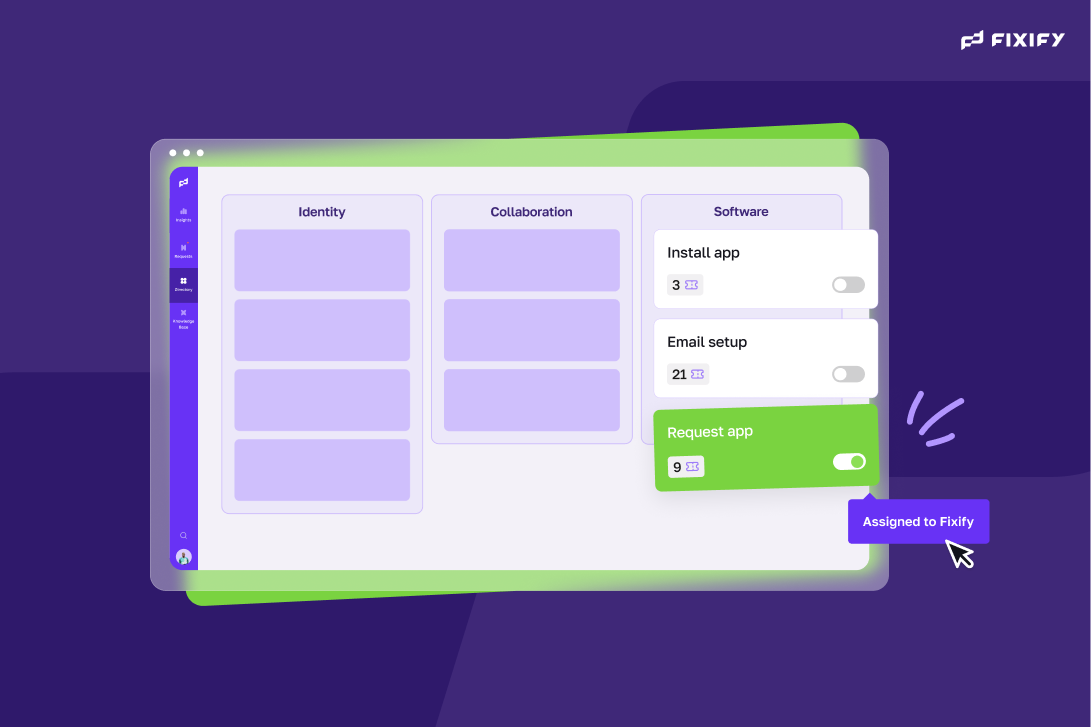AI in ITSM: The honest challenges Fixify has seen

.png)
Listen to this blog as a podcast

.png)
AI in IT service management is exciting, but it doesn’t equal automatic value. You still need clean inputs, guardrails, and a plan for when and where humans step in. That’s how you earn and protect trust while you scale your help desk.
This piece explores the real hurdles we encounter when teams implement AI in ITSM. Additionally, how to implement a practical approach that strikes the balance between automation and human oversight. You’ll also find where to start if you’re early, and how to measure what matters.
If you aim to scale support without adding headcount, this will help you make the right first moves and avoid rework later.
Why AI in ITSM isn’t a silver bullet
AI can streamline repetitive work in IT service management and allow your help desk to operate more efficiently. It can triage, summarize, and suggest resolutions. It can also miss the mark when context is thin or the process is messy.
That’s what we’ve seen in real deployments. The upside is real. The gaps are real, too.
Guidance, such as the NIST AI Risk Management Framework, makes the same point. AI requires human oversight and risk management to maintain trust and quality, not just more IT automation.
Challenge 1: Incomplete or outdated knowledge bases
AI needs accurate knowledge to resolve tickets satisfactorily. Many teams don’t have it, or it resides in scattered documents that reflect how work was done in the past. That’s when AI starts guessing, and agents end up spending more time cleaning up.
What it looks like in practice
The AI assistant proposes steps that worked for your VPN client three versions ago. Or it cites a deprecated entitlement path. Users get stuck. Tickets reopen. Confidence drops.
Trends in the AI Index 2024 echo this reality. Reliability improves when systems have strong ground truth, and it degrades when they do not.
How to fix it
Treat knowledge as a live system, not a Wiki you update twice a year. Map high-volume issues, then align knowledge articles to those flows. Use simple governance.
If an article powers automation, it must have an owner and a review date. Practices from ITIL 4 point to the same idea. Get the right information to the right people at the right time, and keep it current.
Challenge 2: Over-automation without human oversight
It’s tempting to try and automate everything. The risk is higher for complex or high-impact tickets, such as incident management. If a self-service bot misroutes an incident or applies the wrong change without human oversight, users stop trusting the channel.
What it looks like in practice
An agentic workflow resets an account during a broader outage, making things worse. Or an incident isn’t escalated to a real person because the intent classifier missed a key detail. Teams then scramble to undo the automation.
How to fix it
Keep people informed when the impact is high or the context is unclear. Build explicit guardrails.
The NIST AI Risk Management Framework emphasizes the importance of governance and continuous monitoring to ensure systems behave as expected in their intended context. In service operations, leaders who see results tend to be more disciplined about design and oversight, not just adoption.
Challenge 3: Misaligned automation priorities
Many teams automate low-impact tasks first because they’re easy. Meanwhile, the queue’s real pain points stay manual. The result is more scripts, same outcomes.
What it looks like in practice
You ship a workflow to auto-tag tickets, but software access and device provisioning still burn hours. Capacity doesn’t change.
How to fix it
Prioritize by two signals. Volume and time saved. Start by identifying a predictable workflow that solves a common problem.
Then expand once the results appear. Market data indicate that AI adoption is increasing, but the value lies in its application, not just in its use.
Challenge 4: Tool sprawl and integration gaps
AI features sit in multiple tools that don’t share context. Ticketing software, identity management, device management, messaging, and monitoring each play a part in the picture. Without integration, your assistant can’t see enough to act with confidence.
What it looks like in practice
SaaS portfolios are large. Licenses overlap. Visibility is thin.
Yearly snapshots like Okta’s Businesses at Work show steady growth in app counts. That fragmentation blocks end-to-end automation because your workflows never have access to the full ticket context.
How to fix it
Pick a few golden paths and wire them front to back. For example, access requests initiated in chat are authorized via identity, logged into your ITSM, and confirmed with the user in the same channel. Use events, not polling, and capture the audit trail in your system of record.
Challenge 5: Measuring the right success metrics
Speed alone can mask quality issues. You can lower mean time to resolution and still frustrate users if the answer isn’t right or if tickets keep reopening.
What it looks like in practice
Dashboards show faster close times, yet first contact resolution and user sentiment are flat. Service quality didn’t change. You just standardized the wrong thing.
How to fix it
Balance operational KPIs with experience KPIs. Track first contact resolution, reopen rate, and user sentiment alongside SLA adherence.
Pair that with lightweight sentiment signals on every interaction. That mix gives you faster service that users trust.
What Fixify has learned about making AI in ITSM work
There’s a repeatable way to make progress without risking service quality. Start where outcomes are predictable, keep people in the loop for exceptions, and expand as you learn. Here’s the pattern we follow when working on tickets with care.
Begin with predictable, high-volume tasks
Focus on requests with stable steps and clean handoffs. Password resets, software installations with standard entitlements, printer setup, basic device troubleshooting, and calendar permissions align well. That’s how you create early wins in IT service management.
Keep humans in the loop for incidents and the edge
Use AI for triage and context gathering. Require human review for incident management, data changes, and any updates that affect multiple users.
AI can summarize, propose, and draft. A human approves or adjusts. That is the line between assistive and autonomous, and it is where trust is built.
Use a 4-step approach: Understand, eliminate, improve, automate
Before we discuss the steps, let's consider why the order matters. You remove noise first, refine the workflow second, then automate only what proves stable.
From there:
- Understand: Instrument your queue. See how time is allocated across categories and systems.
- Eliminate: Remove tickets entirely by fixing upstream issues. Pre-provision the right tools for new hires so you avoid access requests.
- Improve: Move simple requests into chat with pre-checks and policy prompts.
- Automate: Only after the flow is stable do you let AI execute the steps.
End with a quick gut check. If you automated a messy flow, stop and reset the order. This simple sequence prevents automating chaos.
Build playbooks from real tickets, not just documentation
Most teams don’t have a pristine knowledge base. That’s fine. Learn from resolved tickets. Capture the steps that led to faster resolution and fewer reopenings.
Turn those into living playbooks and keep them up to date. Over time, this provides your AI and agents with the same source of truth.
Where to start if you’re exploring AI in ITSM
If you’re early, you don’t need a moonshot. You need a clear place to begin, a way to measure results, and a plan to expand without breaking what works.
Audit current workflows
List the top categories by volume and handle time. Identify which ones have a repeatable path to resolution. You now have your shortlist for AI-assisted workflows. Tie each to its systems in play across the IT infrastructure.
Test in controlled areas
Pick one or two flows. Add AI to triage, summarize, and draft steps. Keep execution behind a human review step — pilot with a subset of users. Track first contact resolution, reopen rate, and sentiment before and after.
Pro tip: Keep a single owner for each pilot so decisions happen fast, and risk has a name.
Design escalation by default
Make it clear how users get to a person. Publish your escalation promise in the channel where requests start.
We use a short line internally, “where AI taps out.” It reminds everyone that care and trust matter more than automation for its own sake.
Build an AI in an ITSM approach that lasts
When AI is integrated into ITSM, it appears simple to the user and predictable to the team. The playbooks are grounded in real ticket data.
Automation handles the repeatable parts. People step in for judgment and care. Governance keeps everything aligned.
A few practical habits to stick with
To keep momentum without drama, make these habits routine:
- Review the automation backlog monthly against the queue to ensure it remains up to date. If volume shifts, your priorities should too.
- Assign owners to knowledge articles that feed automations. Owners get nudged before expiry.
- Treat sentiment as a first-class signal. If it dips, pause the workflow and identify and resolve the root cause.
- Keep a single view of the ticket context. Consolidate or integrate to reduce swivel-chair work.
Close each month by looking at outcomes, not just activity. Small rituals create steady gains that compound over time.
Why this matters
You aren't replacing your team; you're giving them time for project work while users achieve better outcomes. Treat AI as an assistant, keep humans involved, and uphold standards for lasting results.
The playbook is simple: start with predictable requests, use understand, eliminate, improve, automate steps, tying automation to real ticket data, not wish lists.
Measure first contact resolution, reopen rate, sentiment, and SLA targets. When these move together, service quality improves. Integrate ticketing, identity, and device tools for a unified view. Make escalation easy and visible. When users feel cared for, adoption increases, and queues lighten without extra staff.
Explore how Fixify can improve your help desk — book a demo today and stay ahead with Fixify's latest ITSM solutions.
Related articles

Fixify Service Catalog: The heat map that shows what IT really does all day


Scaling up Okta Workflows: What IT teams learn after the first 10 flows


AI adoption challenges in IT service management: How fixify helps you avoid the pitfalls and reap the rewards

Stay in the loop

Sign up to get notified about our latest news and blogs
.png)